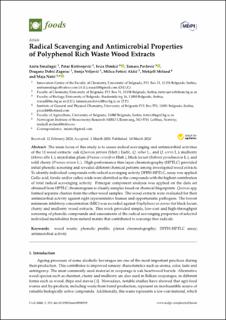| dc.contributor.author | Smailagic, Anita | |
| dc.contributor.author | Ristivojevic, Petar | |
| dc.contributor.author | Dimkic, Ivica | |
| dc.contributor.author | Pavlovic, Tamara | |
| dc.contributor.author | Zagorac, Dragana Dabic´ | |
| dc.contributor.author | Veljovic, Sonja | |
| dc.contributor.author | Akšic, Milica Fotiric´ | |
| dc.contributor.author | Meland, Mekjell | |
| dc.contributor.author | Natic, Maja | |
| dc.date.accessioned | 2020-11-03T09:36:49Z | |
| dc.date.available | 2020-11-03T09:36:49Z | |
| dc.date.created | 2020-04-02T18:34:09Z | |
| dc.date.issued | 2020-03-10 | |
| dc.identifier.citation | Foods. 2020, 9 (3), 1-15. | en_US |
| dc.identifier.issn | 2304-8158 | |
| dc.identifier.uri | https://hdl.handle.net/11250/2686151 | |
| dc.description.abstract | The main focus of this study is to assess radical scavenging and antimicrobial activities of the 11 wood extracts: oak (Quercus petraea (Matt.) Liebl., Q. robur L., and Q. cerris L.), mulberry (Morus alba L.), myrobalan plum (Prunus cerasifera Ehrh.), black locust (Robinia pseudoacacia L.), and wild cherry (Prunus avium L.). High-performance thin-layer chromatography (HPTLC) provided initial phenolic screening and revealed different chemical patterns among investigated wood extracts. To identify individual compounds with radical scavenging activity DPPH-HPTLC, assay was applied. Gallic acid, ferulic and/or caffeic acids were identified as the compounds with the highest contribution of total radical scavenging activity. Principal component analysis was applied on the data set obtained from HPTLC chromatogram to classify samples based on chemical fingerprints: Quercus spp. formed separate clusters from the other wood samples. The wood extracts were evaluated for their antimicrobial activity against eight representative human and opportunistic pathogens. The lowest minimum inhibitory concentration (MIC) was recorded against Staphylococcus aureus for black locust, cherry and mulberry wood extracts. This work provided simple, low-cost and high-throughput screening of phenolic compounds and assessments of the radical scavenging properties of selected individual metabolites from natural matrix that contributed to scavenge free radicals. | en_US |
| dc.language.iso | eng | en_US |
| dc.publisher | MDPI, Basel, Switzerland | en_US |
| dc.rights | Navngivelse 4.0 Internasjonal | * |
| dc.rights.uri | http://creativecommons.org/licenses/by/4.0/deed.no | * |
| dc.title | Radical Scavenging and Antimicrobial Properties of Polyphenol Rich Waste Wood Extracts | en_US |
| dc.type | Peer reviewed | en_US |
| dc.type | Journal article | en_US |
| dc.description.version | publishedVersion | en_US |
| dc.rights.holder | © 2020 by the authors | en_US |
| dc.source.pagenumber | 1-15 | en_US |
| dc.source.volume | 9 | en_US |
| dc.source.journal | Foods | en_US |
| dc.source.issue | 3 | en_US |
| dc.identifier.doi | 10.3390/foods9030319 | |
| dc.identifier.cristin | 1805072 | |
| dc.relation.project | Norges forskningsråd: 280376 | en_US |
| cristin.ispublished | true | |
| cristin.fulltext | original | |
| cristin.qualitycode | 1 | |

